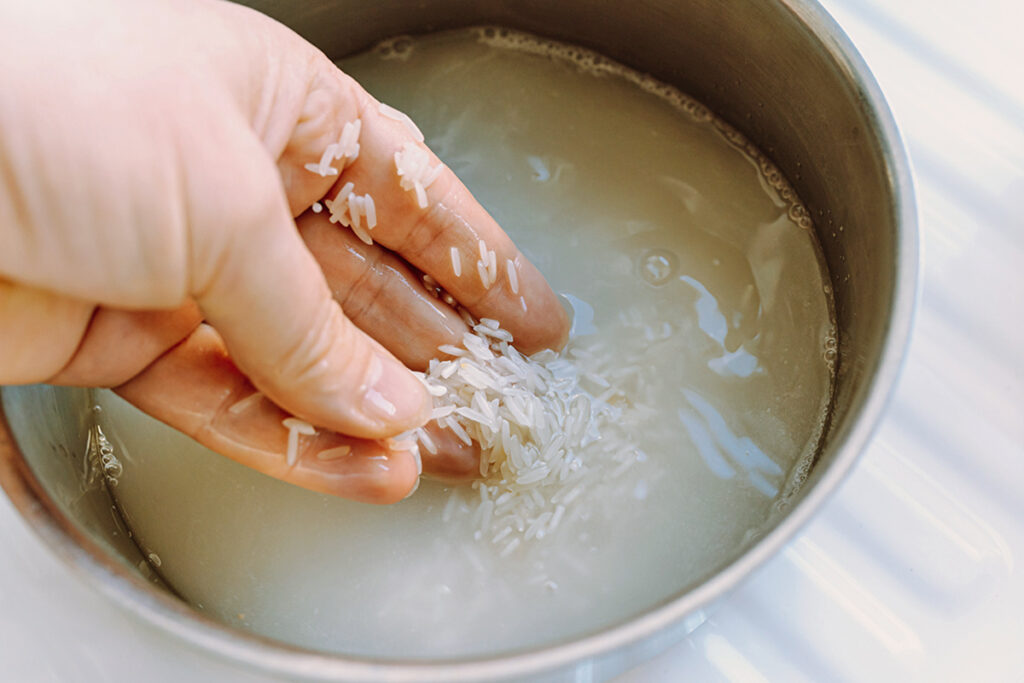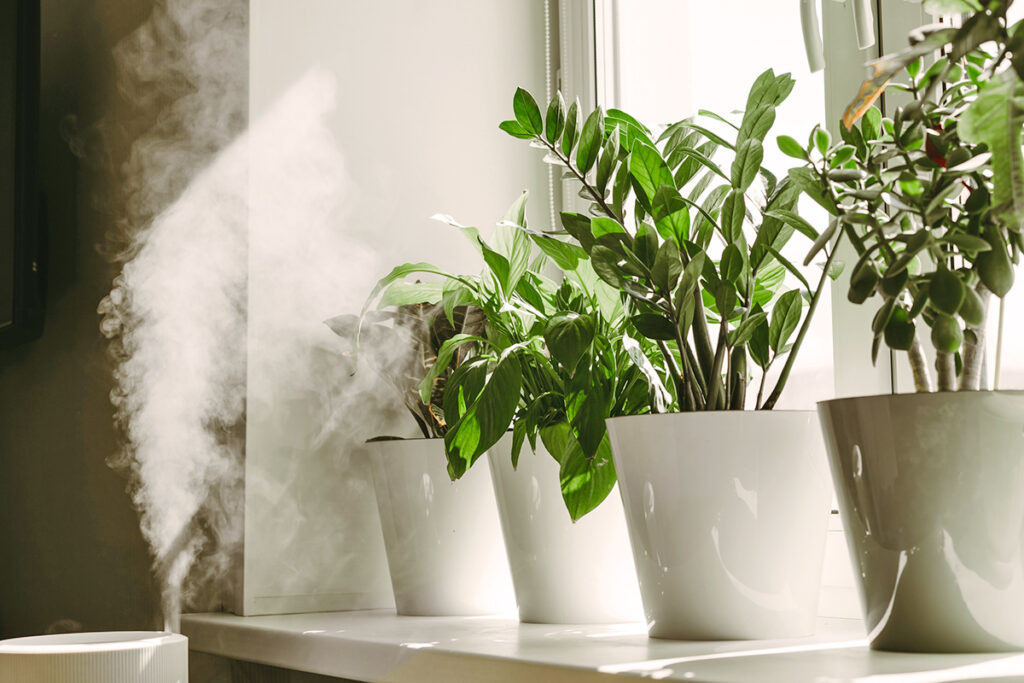Having a collection of flourishing plants is a proud achievement, but every gardener knows that even the healthiest specimens can suddenly go rogue. Sometimes the most thought-out watering and fertilizing schedules, the best drainage solutions, and the perfect sunny spots still aren’t enough to keep plants thriving. Fortunately, there are numerous plant care hacks that…
Whether you’re new to plant parenthood or a seasoned pro with a growing collection of greens, these essential tips and tricks can help you tackle everything from humidity and sunlight levels to every plant parent’s archnemesis: pests.
1. Cover Plants in Plastic Bags To Boost Growth
Did you know you can create a greenhouse using only a plastic bag? Simply place a transparent plastic bag over your plant to increase humidity and promote growth. Since most houseplants are tropical, adequate humidity is key. The increased moisture opens up the leaf pores, which allows plants to absorb carbon dioxide more effectively during photosynthesis. It can also help prevent wilting or crispy leaf edges. However, you should avoid placing plants in sunny spots while using this hack, as the intensified heat can cause scorching.

More from our network
House Outlook is part of Inbox Studio, which publishes content that uplifts, informs, and inspires.
2. Use a Fan To Strengthen Stems
Indoor houseplants can benefit from an occasional at-home workout. To strengthen your plants’ stems, simulate wind using a standing or tabletop fan. The movement triggers a process that redirects growth hormones, specifically auxin, to build thicker, stronger stems.
3. Pair Plant Cuttings With Pothos
Pothos are among the easiest houseplants to care for and propagate. Whether you plan to make more pothos plants or not, you can use pothos cuttings as a growth booster for other plant cuttings during the propagation process by placing them together in the same vessel of water. Since pothos naturally produces a rooting hormone called auxin, it can directly encourage other plant cuttings to put down new roots. If you’re growing pothos in water — which can be done indefinitely — you can feed its auxin-rich water to other houseplants every time you refresh its supply.
4. Water Soil Heavily Before a Frost
If you have an outdoor garden, frost is a major concern. To protect your plants during a cold snap, thoroughly water the soil late in the day before the overnight freeze. Because wet soil holds heat better than dry soil, this strategy can help insulate the roots and prevent damage during the chilliest parts of the night.
5. Fertilize Plants With Rice Water
Fertilization is an essential part of plant care, but before you invest in expensive fertilizer, consider using leftover rice water instead. Rinsing rice before cooking removes excess starch for a fluffier finish, and that leftover water is packed with beneficial nutrients, including nitrogen, phosphorus, potassium, calcium, iron, vitamins, and minerals.



6. Turn Plants To Prevent Leaning
It’s not uncommon for plants to start leaning toward the light source. And while a stake can help ensure they stay somewhat upright, they’ll still stretch their leaves toward the sun. To reduce leaning, give your plants a regular rotation. A quarter turn every four to 14 days is best, but you can also rotate your plants slightly every time you water them.
7. Try a Two-Pot Method
Decorative planters look great, but they can have a damaging effect on your plants because many don’t have adequate drainage holes. Instead, use a two-pot method: Keep your plant in its plastic nursery pot and then place that pot within the decorative planter. Just remember to pull the inner pot out for watering, allowing it to drain completely before returning it to the decorative pot.
8. Grow Plants Directly in Water
Fun fact: Some plants don’t actually need soil to survive. Instead, you can grow certain varieties, such as pothos, lucky bamboo, and spider plants, directly in water. This approach can reduce the risk of overwatering, root rot, and other soil-related issues.
9. Choose a Pot Based on the Root Ball
Most of us look at a plant and choose a pot based on its current container size. However, pot size should always be determined by the size of the root ball, not the visible part of the plant. So, if you have a larger plant but the root ball is small, a massive pot isn’t necessary — in fact, it could actually harm your plant by making it susceptible to root rot.
10. Use a Humidifier To Simulate a Tropical Environment
Humidity is an important, yet often overlooked part of plant care. This is especially true if you live in a dry climate and have a collection of tropical varieties. To boost humidity, try running a humidifier in your home. Set the humidifier a few feet away from your plants, aligning it with their height, and aim the mist across the front of your plant group, rather than directly at them. Beyond adding moisture to the air, humidifiers can make a room feel warmer, which is particularly helpful for winter plant care.

11. Use a Chopstick To Determine Watering Schedules
Figuring out your plant’s watering schedule doesn’t have to be a guessing game. Instead, reach for an untreated wooden chopstick or skewer and stick it into the soil at a 45-degree angle, reaching the bottom of the pot or close to it. (You should also keep about 2 to 3 inches of space from the plant’s stem to avoid causing any root damage.) If the stick comes back damp with some soil stuck to it, hold off on watering. If it comes back dry, it’s time to water.
12. Use Plastic Nursery Pots To Get a Perfect Fit When Repotting
If you’re repotting your plant, you can save yourself a lot of the mess (and hassle) by using this trick: Begin by gently squeezing the bottom and sides of the nursery pot to release the plant. Add a few inches of soil to the new pot, then place the empty nursery container in the center. Fill the remaining space with soil, remove the nursery container, and finally, put your plant into the perfectly sized hole.
13. Boost Plant Health With Crushed Eggshells
In addition to rice water, crushed eggshells are another kitchen scrap that can work wonders in your garden. Since eggshells are rich in calcium, these scraps can help nourish soil and strengthen plant growth. The texture also adds aeration to your soil, creating a more friendly environment for plant roots to thrive, while simultaneously warding off slugs and snails, who dislike the feel of the sharp edges on their soft bellies.
14. Ward Off Pests Naturally With Citrus Peels
Citrus peels are packed with limonene, a chemical compound that many garden pests hate, including flies, ants, aphids, and mosquitoes. To reduce these unwanted visitors in your garden, chop up fresh or dried citrus peels and scatter them onto your soil. Be sure to replace the peels often so they don’t get moldy or lose their potent scent.
15. Try the Bathtub Method To Water Plants While Out of Town
Taking a vacation can put a damper on your plants’ health, but there are ways to ensure that your plant babies thrive while you’re away. Consider filling your bathtub with 2 to 3 inches of water and placing your potted plants in the bath so they can bottom-feed while you’re relaxing poolside.

16. Use Fuzzy Socks To Dust Plant Leaves
Removing dust from plant leaves is essential, not just for reducing household allergens, but also for ensuring they can fully absorb sunlight for photosynthesis. Instead of reaching for a wet paper towel or a pricey dusting tool, look in your sock drawer for a pair of fuzzy socks. Similar to microfiber towels, these socks are excellent at picking up dust without spreading it around.
17. Repot Overwatered Plants in Fresh Soil
If you accidentally overwatered your plant and you sense a bit of root rot, don’t wait for the soil to dry out on its own. Instead, immediately remove the plant from its pot and gently rinse the roots until all the old, soggy soil is washed away. Cut back any rotted, mushy roots, and then repot the plant using fresh soil.
18. Cut Back on Watering in the Winter
Plants don’t need as much water in the winter because most are in a state of dormancy. In fact, overwatering during this period can actually do more harm than good. If you want your plants to thrive come spring, cut back on your watering schedule. This allows the plants to conserve the energy they need for the spring growing season.
19. Target Fungus Gnats With a Dash of Cinnamon
Fungus gnats are one of the worst things about being a plant parent. If you find yourself battling these tiny insects, try sprinkling ground cinnamon on top of your plant’s soil. The spice acts as a powerful natural fungicide, killing the fungus that gnat larvae feed on and ultimately reducing their chances of surviving to maturity.
20. Increase Sunlight With Aluminum Foil
Plants need sunlight to thrive, but we can’t always supply enough of it. If you live in a dim space or if light is less abundant in the winter, make a “sun box” using aluminum foil to reflect and intensify the available light. Learn how to create a sun box for your plants here.


















